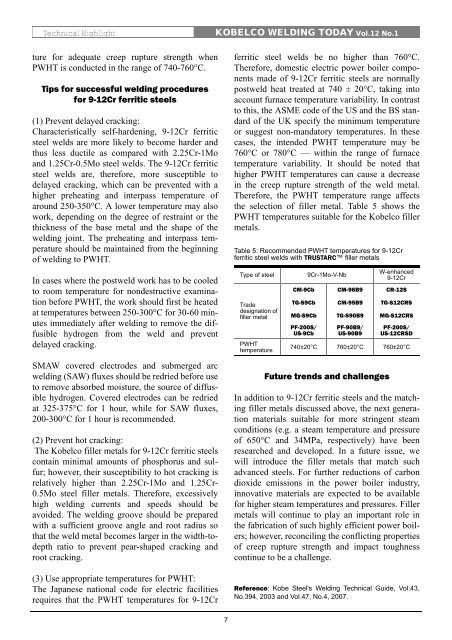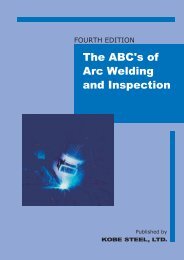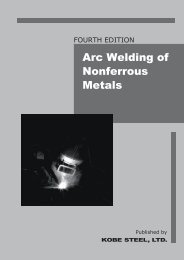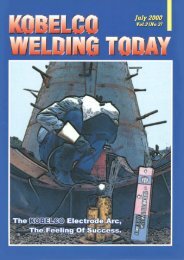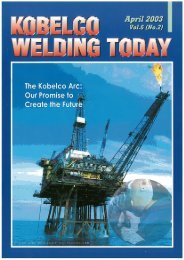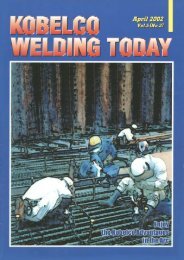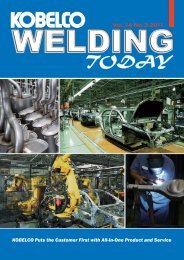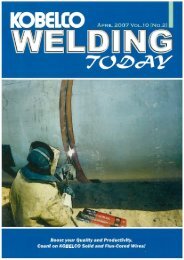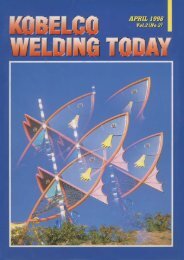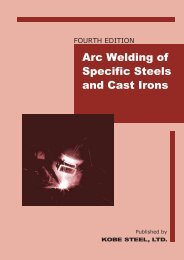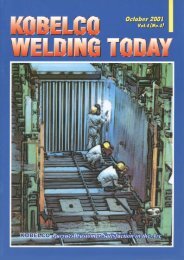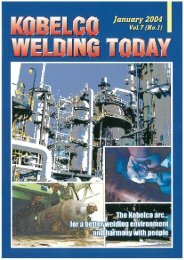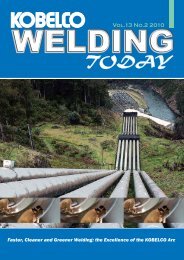Kobelco Welding Today Vol.12 No.1 2009
Kobelco Welding Today Vol.12 No.1 2009
Kobelco Welding Today Vol.12 No.1 2009
You also want an ePaper? Increase the reach of your titles
YUMPU automatically turns print PDFs into web optimized ePapers that Google loves.
Technical Highlight<br />
KOBELCO WELDING TODAY <strong>Vol.12</strong> <strong>No.1</strong><br />
ture for adequate creep rupture strength when<br />
PWHT is conducted in the range of 740-760°C.<br />
Tips for successful welding procedures<br />
for 9-12Cr ferritic steels<br />
(1) Prevent delayed cracking:<br />
Characteristically self-hardening, 9-12Cr ferritic<br />
steel welds are more likely to become harder and<br />
thus less ductile as compared with 2.25Cr-1Mo<br />
and 1.25Cr-0.5Mo steel welds. The 9-12Cr ferritic<br />
steel welds are, therefore, more susceptible to<br />
delayed cracking, which can be prevented with a<br />
higher preheating and interpass temperature of<br />
around 250-350°C. A lower temperature may also<br />
work, depending on the degree of restraint or the<br />
thickness of the base metal and the shape of the<br />
welding joint. The preheating and interpass temperature<br />
should be maintained from the beginning<br />
of welding to PWHT.<br />
In cases where the postweld work has to be cooled<br />
to room temperature for nondestructive examination<br />
before PWHT, the work should first be heated<br />
at temperatures between 250-300°C for 30-60 minutes<br />
immediately after welding to remove the diffusible<br />
hydrogen from the weld and prevent<br />
delayed cracking.<br />
SMAW covered electrodes and submerged arc<br />
welding (SAW) fluxes should be redried before use<br />
to remove absorbed moisture, the source of diffusible<br />
hydrogen. Covered electrodes can be redried<br />
at 325-375°C for 1 hour, while for SAW fluxes,<br />
200-300°C for 1 hour is recommended.<br />
(2) Prevent hot cracking:<br />
The <strong>Kobelco</strong> filler metals for 9-12Cr ferritic steels<br />
contain minimal amounts of phosphorus and sulfur;<br />
however, their susceptibility to hot cracking is<br />
relatively higher than 2.25Cr-1Mo and 1.25Cr-<br />
0.5Mo steel filler metals. Therefore, excessively<br />
high welding currents and speeds should be<br />
avoided. The welding groove should be prepared<br />
with a sufficient groove angle and root radius so<br />
that the weld metal becomes larger in the width-todepth<br />
ratio to prevent pear-shaped cracking and<br />
root cracking.<br />
(3) Use appropriate temperatures for PWHT:<br />
The Japanese national code for electric facilities<br />
requires that the PWHT temperatures for 9-12Cr<br />
ferritic steel welds be no higher than 760°C.<br />
Therefore, domestic electric power boiler components<br />
made of 9-12Cr ferritic steels are normally<br />
postweld heat treated at 740 ± 20°C, taking into<br />
account furnace temperature variability. In contrast<br />
to this, the ASME code of the US and the BS standard<br />
of the UK specify the minimum temperature<br />
or suggest non-mandatory temperatures. In these<br />
cases, the intended PWHT temperature may be<br />
760°C or 780°C — within the range of furnace<br />
temperature variability. It should be noted that<br />
higher PWHT temperatures can cause a decrease<br />
in the creep rupture strength of the weld metal.<br />
Therefore, the PWHT temperature range affects<br />
the selection of filler metal. Table 5 shows the<br />
PWHT temperatures suitable for the <strong>Kobelco</strong> filler<br />
metals.<br />
Table 5: Recommended PWHT temperatures for 9-12Cr<br />
ferritic steel welds with TRUSTARC filler metals<br />
Type of steel<br />
Trade<br />
designation of<br />
filler metal<br />
PWHT<br />
temperature<br />
9Cr-1Mo-V-Nb<br />
Future trends and challenges<br />
W-enhanced<br />
9-12Cr<br />
CM-9Cb CM-96B9 CR-12S<br />
TG-S9Cb CM-95B9 TG-S12CRS<br />
MG-S9Cb TG-S90B9 MG-S12CRS<br />
PF-200S/<br />
US-9Cb<br />
PF-90B9/<br />
US-90B9<br />
PF-200S/<br />
US-12CRSD<br />
740±20°C 760±20°C 760±20°C<br />
In addition to 9-12Cr ferritic steels and the matching<br />
filler metals discussed above, the next generation<br />
materials suitable for more stringent steam<br />
conditions (e.g. a steam temperature and pressure<br />
of 650°C and 34MPa, respectively) have been<br />
researched and developed. In a future issue, we<br />
will introduce the filler metals that match such<br />
advanced steels. For further reductions of carbon<br />
dioxide emissions in the power boiler industry,<br />
innovative materials are expected to be available<br />
for higher steam temperatures and pressures. Filler<br />
metals will continue to play an important role in<br />
the fabrication of such highly efficient power boilers;<br />
however, reconciling the conflicting properties<br />
of creep rupture strength and impact toughness<br />
continue to be a challenge.<br />
Reference: Kobe Steel's <strong>Welding</strong> Technical Guide, Vol.43,<br />
No.394, 2003 and Vol.47, No.4, 2007.<br />
7


